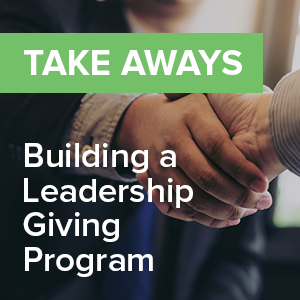You’ve got a job, you’ve got meetings, you’ve got a lunch to eat in peace. We get it. You can’t always carve out time to tune in to a live webinar. Or even watch the recording at your leisure (but if you wanted to, you can watch it at your leisure here).
Lucky for you we watched it. And helped plan it and post it and, honestly, it feels like this Leadership Giving webinar is the only thing we’ve thought about all week. If you don’t have time to watch the whole thing, these are the Leadership Giving lessons that jumped out at us.
There’s No One, Correct Way to Approach Leadership Giving
Kansas State, Syracuse and the College of Charleston are all after (more or less) the same thing: more mid-tier gifts. Too often, 90% of a fundraising team’s effort is focused exclusively on the top 10% of donors. Regardless of your institution, mid-tier gifts is likely a huge, untapped resource.
While they whole heartedly agreed on that fact, our panelists don’t have the same definition of what a mid-tier gift is. And their organizations are definitely not mirror images of one another.
They share some similarities, for sure. But the commonality you should seek to replicate is their shared sense of curiosity at the outset of their programs. Each studied similar programs for inspiration but took a critical lens to how a Leadership Giving program would work best at their school then tweaked it accordingly as they kicked off their own programs.
Define Your Identity from the Start
If you’re thinking about a Leadership Giving program, one of the first things you’ll want to do is define your parameters. Major Gift officers are not going to want you creeping in on their territory and neither is the Annual Fund crowd. Define exactly what you’re aiming to do and why it’s an underserved market
It’s important to note that this does not mean, necessarily, committing to success metrics right from the get go. While you want to define your scope with some precision, give yourself room to breathe and evolve as you see what works, what doesn’t and what you didn’t think of as your program evolves over the first few months or year.
It’s OK for Things to Be a Work in Progress at the Start (And Possibly Forever)
Leadership Giving is a whole new area for almost every school out there. A long-standing program might have been around for ten years. It’s perfectly alright if you don’t have all the answers when you get up and running. In fact, it might be a little strange if you did.
As long as you’ve defined your identity and set about working within those parameters, you’ll start to see where your holes are. Gather data, try some things out and then make sure to carve out time to do the most important thing for your program: Reflect on your progress. We know it’s a demanding environment and you always want to keep pushing forward. But every few months, make sure to take a deep breath and carve out some meaningful time to stop and look back and what you’re doing, what’s working, what isn’t and how you can improve the areas that are falling short. Serious reflection is the surest way for your program to improve.
Invest in Your People and Technology
One thing Kansas State, Syracuse and College of Charleston all agreed on was thinking beyond the metrics that relate specifically to your fundraising numbers. To have a successful Leadership Giving program, and a fundraising department as a whole, you need to seriously invest in your people and the technology they use.
Your people are your biggest weapon. And as this is an emerging and exciting area of fundraising, all three our panelists found that it’s been a great opportunity to get new, younger talent into their organizations. They also acknowledged that it’s not enough to just get them on board. They have to keep challenging them and allowing them to grow their careers.
A big part of that is making sure that their staff has modern technology at the fingertips. The younger generation of talent, having grown up with technology always ever present, has expectations when it comes to the quality of the tools at their disposal. And if they feel like they’re working in an antiquated industry, they’re unlikely to stick around long.
And since your Leadership Giving program is only as good as the people putting their hard work into it, taking care of them and the technology they use should arguably be priority number one.
